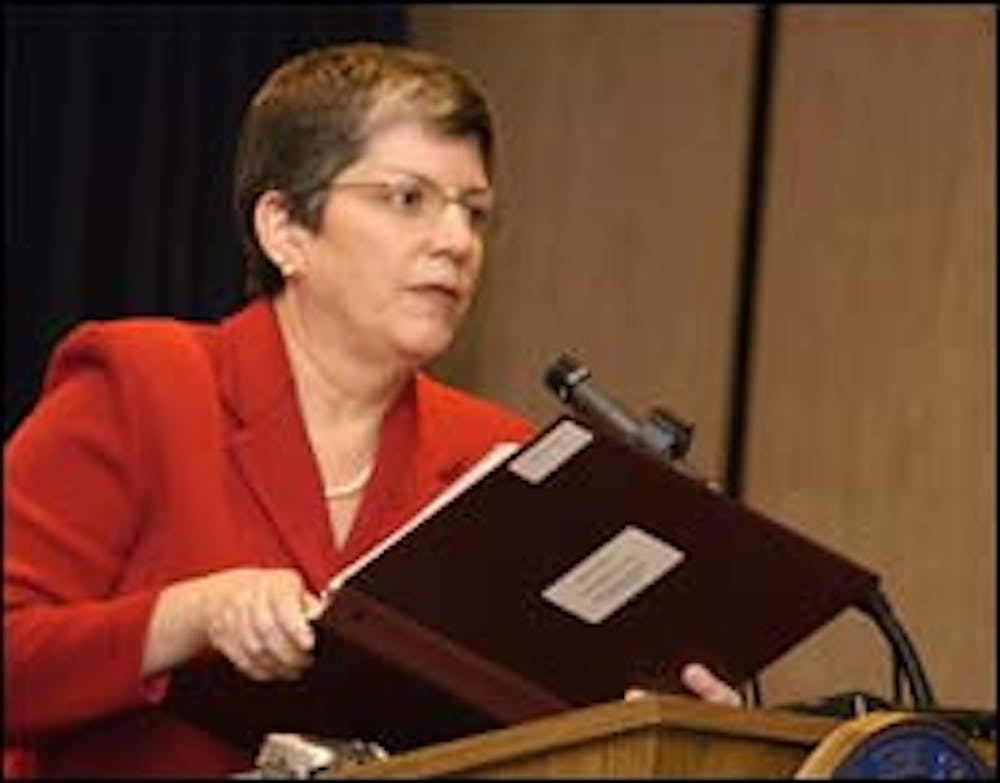Gov. Janet Napolitano's 2005 budget recommendation is "positive news" for ASU, said ASU President Michael Crow.
While it is still too early to determine where state money will go, enrollment-growth funding is ASU's top priority, Crow said.
The recommendation, unveiled Jan. 15, included $792.8 million for all three Arizona universities and the Arizona Board of Regents.
"We really are focused on where Arizona is going, and universities are a place to invest," Napolitano said. "This budget is balanced. We can't do everything we want all in one year, but we certainly can set some long-term targets and begin to fund them."
ASU requested a $54.2 million increase from last year's funds to cover enrollment growth for the past two years, health and retirement costs for employees, and support for new facilities at ASU's main, east, and west campuses.
The total amount ASU requested for 2005 was $365.9 million.
Napolitano recommended a $23.4 million increase for ASU main, east and west campuses.
The total amount the governor recommended for all three ASU campuses was $335.3 million.
The money would be used to pay for enrollment growth and a university pay package, which would fund employee salaries and other needs.
"It's not a great deal of money, but it's more than we've gotten in previous years," said Jim Sliwicki, ASU director of budget planning and management.
In the past
Last year, ASU requested a $26.6 million increase from the school's fiscal year 2003 budget.
The governor's 2004 budget proposal would have partially funded this request, adding a total of $6 million to the fiscal year 2003 budget for the entire Arizona University system.
However, the Legislature recommended cutting the three Arizona universities' funding by $1.1 million.
The two budget recommendations were reconciled so the universities received no increase from their fiscal year 2003 budget.
ASU received $311.8 million for 2004.
While ASU did not take a budget cut in 2004, the University's student body continued to grow. With no increased budget, ASU's funding per full-time student dropped from $6,239; in 2003 to $5,966 in 2004, said Scott Smith, ASU's director of state and local government relations.
Because of this drop in per-student funding, enrollment growth is the top priority in this year's budget request.
More students, less money
According to Crow, enrollment-growth funding pays for "core needs," including "additional faculty to ensure adequate faculty numbers to maintain high quality education students expect from ASU."
ASU has not received full core funding in 20 years, despite a 22,500 increase in students between 1975 and today.
"One of the reasons our request is so large is we're growing so much," Sliwicki said.
For a time, ASU was considering an enrollment cap, which means it would have to start turning students away because of lack of money.
However, Crow said an enrollment cap would only be "considered if it appeared academic quality at ASU would be compromised."
Smith said that the state's tight budget means it can't fully fund enrollment growth.
"We'll get through 2005 and hopefully the economy will continue to rebound," he added. "It's not everything we would want, but it's enough to get us by."
Smith said the University's first priority is to fund enrollment growth, but the amount of money ASU will actually get is yet to be determined.
First, the state Legislature has to present its 2005 budget recommendation, expected sometime this week. Eventually, the governor and the Legislature will come up with a compromised amount, and ASU will receive its funds in July 2005.
"I think the Legislature recognizes that high education and the university system is an asset to the economic development in the state of Arizona," Smith said. "There is support among legislators who want to increase funding for higher education."
Smith said he plans to lobby the Legislature to support the governor's budget recommendation.
Funding sources
In 2003, ASU received 37 percent of its funding from state appropriations. Tuition and fees made up 24 percent and grants and contracts 19 percent.
Revenues from the bookstore, residence halls, parking and intercollegiate athletics made up 11 percent of funds. The other nine percent of funds came from sales and services, private gifts such as the $50 million endowments from Ira A. Fulton and W. P. Carey, and technology and research money, which is generated from a 0.6 percent education sales tax approved by Arizona voters in 2000.
Crow has not yet decided whether to propose a tuition increase for to the board of regents in order to compensate for state funding shortfalls.
Reach the reporters at lindsay.butler@asu.edu, and amanda.keim@asu.edu.




